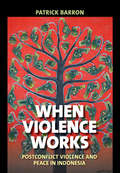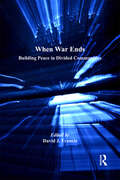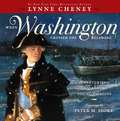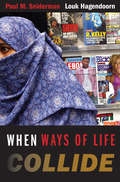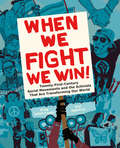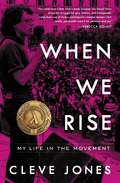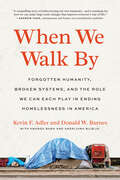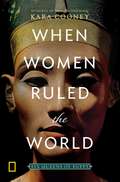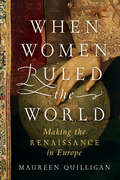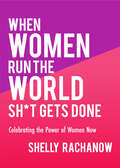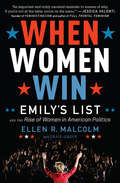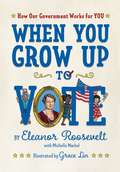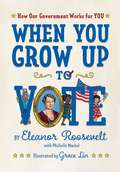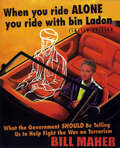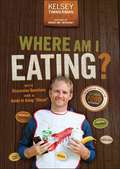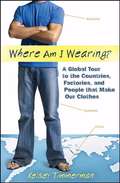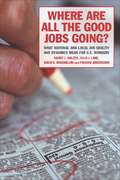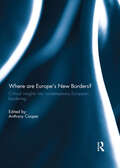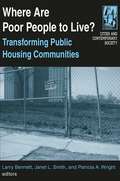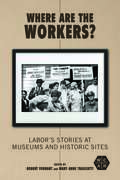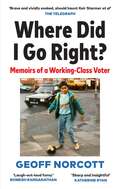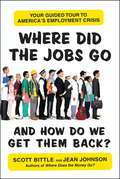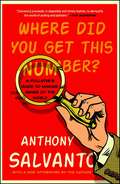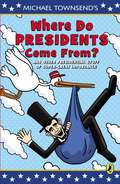- Table View
- List View
When Violence Works: Postconflict Violence and Peace in Indonesia
by Patrick BarronWhy are some places successful in moving from war to consolidated peace while others continue to be troubled by violence? And why does postconflict violence take different forms and have different intensities? By developing a new theory of postconflict violence Patrick Barron's When Violence Works makes a significant contribution to our understanding. Barron picks out three postconflict regions in Indonesia in which to analyze what happens once the "official" fighting ends: North Maluku has seen peace consolidated; Maluku still witnesses large episodes of violence; and Aceh experiences continuing occurrences of violence but on a smaller scale than in Maluku. He argues that violence after war has ended (revenge killings, sexual violence, gang battles, and violent crime, in addition to overtly political conflict) is not the result of failed elite bargains or weak states, but occurs because the actors involved see it as beneficial and lowcost. His findings pertain directly to Indonesia, but the theory will have relevance far beyond as those studying countries such as Colombia, the Philippines, Iraq, Afghanistan, and Syria seek a framework in which to assess what happens after war ends. Barron's theory also provides practical guidance for policymakers and development practitioners. Ultimately, When Violence Works pushes forward our understanding of why postconflict violence occurs and takes the forms it does.
When War Ends: Building Peace in Divided Communities
by David J. FrancisThis volume critically examines what happens when war formally ends, the difficult and complex challenges and opportunities for winning the peace and reconciling divided communities. By reviewing a case study of the West African state of Sierra Leone, potential lessons for other parts of the world can be gained. Sierra Leone has emerged as a 'successful' model of liberal peacebuilding that is now popularly advertised and promoted by the international community as a powerful example of a country that they finally got right. Concerns about how successful a model Sierra Leone actually is, are outlined in this project. As such this volume: -
When Washington Crossed The Delaware: A Wintertime Story For Young Patriots
by Lynne Cheney Peter M. FioreChristmas night, 1776, was a troubled time for our young country. In the six months since the Declaration of Independence had been signed, General George Washington and his troops had suffered defeat after defeat at the hands of the British. It looked as though our struggle for independence might be doomed, when Washington made a bold decision. He would lead the main body of his army across the Delaware River and launch a surprise attack on enemy forces. <p><p> Washington and his men were going against the odds. It seemed impossible that the ragtag Americans could succeed against the mightiest power in the world. But the men who started across the icy Delaware loved their country and their leader. Under his command they would turn the tide of battle and change the course of history. <p><p> Now in paperback for the first time, this story of the military campaign that began on Christmas night in 1776 will teach readers about the heroism, persistence, and patriotism of those who came before them.
When Ways of Life Collide: Multiculturalism and Its Discontents in the Netherlands
by Paul M. Sniderman Louk HagendoornIn 2004, Dutch filmmaker Theo van Gogh was brutally murdered on a busy Amsterdam street. His killer was Mohammed Bouyeri, a twenty-six-year-old Dutch Moroccan offended by van Gogh's controversial film about Muslim suppression of women. The Dutch government had funded separate schools, housing projects, broadcast media, and community organizations for Muslim immigrants, all under the umbrella of multiculturalism. But the reality of terrorism and radicalization of Muslim immigrants has shattered that dream. In this arresting book, Paul Sniderman and Louk Hagendoorn demonstrate that there are deep conflicts of values in the Netherlands. In the eyes of the Dutch, for example, Muslims oppress women, treating them as inferior to men. In the eyes of Muslim immigrants, Western Europeans deny women the respect they deserve. Western Europe has become a cultural conflict zone. Two ways of life are colliding. Sniderman and Hagendoorn show how identity politics contributed to this crisis. The very policies meant to persuade majority and minority that they are part of the same society strengthened their view that they belong to different societies. At the deepest level, the authors' findings suggest, the issue that government and citizens need to be concerned about is not a conflict of values but a clash of fundamental loyalties.
When We Fight, We Win
by Greg Jobin-Leeds AgitarteSame-sex marriage, #BlackLivesMatter, the DREAM Act, the People's Climate March, End the New Jim Crow, Occupy Wall Street, the fight for a $15 minimum wage-these are just a few of the remarkable movements that have blossomed in the past decade, a most fertile and productive era of activism. Now, in a visually rich and deeply inspiring book, the leaders and activists of these and other movements distill their wisdom, sharing lessons of what makes-and what hinders-transformative social change.Longtime social activist Greg Jobin-Leeds joins forces with AgitArte, a collective of artists and organizers, to capture the stories, philosophy, tactics, and art of today's leading social change movements. When We Fight, We Win! weaves together interviews with today's most successful activists and artists from across the country and beyond-including Patrisse Cullors-Brignac, Bill McKibben, Clayton Thomas-Muller, Karen Lewis, Favianna Rodriguez, Rea Carey, and Gaby Pacheco, among others-with narrative recountings of strategies and campaigns alongside full-color photos. It includes a foreword by Rinku Sen and an afterword by Antonia Darder.When We Fight, We Win! will give a whole generation of readers the chance to celebrate and benefit from a remarkable decade of activism-a decade that shows just how ripe these times are for social transformation. <P><P><i>Advisory: Bookshare has learned that this book offers only partial accessibility. We have kept it in the collection because it is useful for some of our members. Benetech is actively working on projects to improve accessibility issues such as these.</i>
When We Rise: My Life in the Movement
by Cleve JonesThe partial inspiration for the forthcoming ABC television mini-series from Academy Award-winning screenwriter Dustin Lance Black, executive producer Gus Van Sant, and starring Guy Pearce, Mary-Louise Parker, Carrie Preston, and Rachel Griffiths. "You could read Cleve Jones's book because you should know about the struggle for gay, lesbian, and transgender rights from one of its key participants--maybe heroes--but really, you should read it for pleasure and joy."--Rebecca Solnit, author of Men Explain Things to Me Born in 1954, Cleve Jones was among the last generation of gay Americans who grew up wondering if there were others out there like himself. There were. Like thousands of other young people, Jones, nearly penniless, was drawn in the early 1970s to San Francisco, a city electrified by progressive politics and sexual freedom. Jones found community--in the hotel rooms and ramshackle apartments shared by other young adventurers, in the city's bathhouses and gay bars like The Stud, and in the burgeoning gay district, the Castro, where a New York transplant named Harvey Milk set up a camera shop, began shouting through his bullhorn, and soon became the nation's most outspoken gay elected official. With Milk's encouragement, Jones dove into politics and found his calling in "the movement." When Milk was killed by an assassin's bullet in 1978, Jones took up his mentor's progressive mantle--only to see the arrival of AIDS transform his life once again. By turns tender and uproarious--and written entirely in his own words--When We Rise is Jones' account of his remarkable life. He chronicles the heartbreak of losing countless friends to AIDS, which very nearly killed him, too; his co-founding of the San Francisco AIDS Foundation during the terrifying early years of the epidemic; his conception of the AIDS Memorial Quilt, the largest community art project in history; the bewitching story of 1970s San Francisco and the magnetic spell it cast for thousands of young gay people and other misfits; and the harrowing, sexy, and sometimes hilarious stories of Cleve's passionate relationships with friends and lovers during an era defined by both unprecedented freedom and possibility, and prejudice and violence alike. When We Rise is not only the story of a hero to the LQBTQ community, but the vibrantly voice memoir of a full and transformative American life--an activist whose work continues today.
When We Walk By: Forgotten Humanity, Broken Systems, and the Role We Can Each Play in Ending Homelessness in America
by Kevin F. Adler Donald W. BurnesHow to end homelessness in America: a must-read guide to understanding housing instability, supporting our unhoused neighbors, and reclaiming our humanity. A deeply humanizing analysis that will change the way you think about poverty and homelessness—for the socially engaged reader of Isabel Wilkerson's Caste and Matthew Desmond's Evicted.Think about the last time that you saw or interacted with an unhoused person. What did you do? What did you say? Did you offer money or a smile, or did you avert your gaze?When We Walk By takes an urgent look at homelessness in America, showing us what we lose—in ourselves and as a society—when we choose to walk past and ignore our neighbors in shelters, insecure housing, or on the streets. And it brilliantly shows what we stand to gain when we embrace our humanity and move toward evidence-based people-first, community-driven solutions, offering social analysis, economic and political histories, and the real stories of unhoused people.Authors Kevin F. Adler and Donald W. Burnes, with Amanda Banh and Andrijana Bilbija, recast chronic homelessness in the U.S. as a byproduct of twin crises: our social services systems are failing, and so is our humanity. Readers will learn:Why our brains have been trained to overlook our unhoused neighborsThe social, economic, and political forces that shape myths like &“all homeless people are addicts&” and &“they&’d have a house if they got a job&”What conservative economics gets wrong about housing insecurityWhat relational poverty is, and how to shift away from &“us versus them&” thinkingThat for many Americans, housing insecurity is just one missed paycheck awayWho &“the homeless&” really are—and why that might surprise youWhat you can do to help, starting todayA necessary, deeply humanizing read that goes beyond theory and policy analysis to offer engaged solutions with compassion and heart, When We Walk By is a must-read for anyone who cares about homelessness, housing solutions, and their own humanity.
When Women Ruled the World: Six Queens of Egypt
by Kara CooneyThis riveting narrative explores the lives of six remarkable female pharaohs, from Hatshepsut to Cleopatra - women who ruled with real power - and shines a piercing light on our own perceptions of women in power today. <P><P>Female rulers are a rare phenomenon - but thousands of years ago in ancient Egypt, women reigned supreme. Regularly, repeatedly, and with impunity, queens like Hatshepsut, Nefertiti, and Cleopatra controlled the totalitarian state as power brokers and rulers. But throughout human history, women in positions of power were more often used as political pawns in a male-dominated society. <P><P>What was so special about ancient Egypt that provided women this kind of access to the highest political office? What was it about these women that allowed them to transcend patriarchal obstacles? What did Egypt gain from its liberal reliance on female leadership, and could today's world learn from its example? <P><P>Celebrated Egyptologist Kara Cooney delivers a fascinating tale of female power, exploring the reasons why it has seldom been allowed through the ages and why we should care.
When Women Ruled the World: Making The Renaissance In Europe
by Maureen QuilliganIn this game-changing revisionist history, a leading scholar of the Renaissance shows how four powerful women redefined the culture of European monarchy in the glorious sixteenth century. The sixteenth century in Europe was a time of chronic destabilization in which institutions of traditional authority were challenged and religious wars seemed unending. Yet it also witnessed the remarkable flowering of a pacifist culture, cultivated by a cohort of extraordinary women rulers—most notably, Mary Tudor; Elizabeth I; Mary, Queen of Scots; and Catherine de’ Medici—whose lives were intertwined not only by blood and marriage, but by a shared recognition that their premier places in the world of just a few dozen European monarchs required them to bond together, as women, against the forces seeking to destroy them, if not the foundations of monarchy itself. Recasting the complex relationships among these four queens, Maureen Quilligan, a leading scholar of the Renaissance, rewrites centuries of historical analysis that sought to depict their governments as riven by personal jealousies and petty revenges. Instead, When Women Ruled the World shows how these regents carefully engendered a culture of mutual respect, focusing on the gift-giving by which they aimed to ensure ties of friendship and alliance. As Quilligan demonstrates, gifts were no mere signals of affection, but inalienable possessions, often handed down through generations, that served as agents in the creation of a steep social hierarchy that allowed women to assume political authority beyond the confines of their gender. “With brilliant panache” (Amanda Foreman), Quilligan reveals how eleven-year-old Elizabeth I’s gift of a handmade book to her stepmother, Katherine Parr, helped facilitate peace within the tumultuous Tudor dynasty, and how Catherine de’ Medici’s gift of the Valois tapestries to her granddaughter, the soon-to-be Grand Duchess of Tuscany, both solidified and enhanced the Medici family’s prestige. Quilligan even uncovers a book of poetry given to Elizabeth I by Catherine de’ Medici as a warning against the concerted attack launched by her closest counselor, William Cecil, on the divine right of kings—an attack that ultimately resulted in the execution of her sister, Mary, Queen of Scots. Beyond gifts, When Women Ruled the World delves into the connections the regents created among themselves, connections that historians have long considered beneath notice. “Like fellow soldiers in a sororal troop,” Quilligan writes, these women protected and aided each other. Aware of the leveling patriarchal power of the Reformation, they consolidated forces, governing as “sisters” within a royal family that exercised power by virtue of inherited right—the very right that Protestantism rejected as a basis for rule. Vibrantly chronicling the artistic creativity and political ingenuity that flourished in the pockets of peace created by these four queens, Quilligan’s lavishly illustrated work offers a new perspective on the glorious sixteenth century and, crucially, the women who helped create it.
When Women Run the World Sh*t Gets Done: Celebrating the Power of Women Now
by Shelly Rachanow“This is a book about the power women have—and are using to help heal the broken bones of this beautiful world.” —Sherry Richert Belul, author of Say it NowPacked with stories of ordinary women doing extraordinary things, this book is a must-have for any woman who has ever dreamt of a better world. Dive into this empowering narrative and read about:A trauma surgeon working to stem the epidemic of gun violenceA professor who ran for office to provide a better role model for her sonsAn educator raising India’s poorest girls out of povertyTeens fighting for clean water, inspiring future generations to continue their workA group of firefighters training to trek across Antarctica, raising awareness for mental health and showing young girls that they are strong and can be anything they chooseActivists from around the world fighting the injustices of inequality and patriarchyOne small action can inspire a movement. And as these women have shown, a movement can change minds . . . and ultimately the world.
When Women Win: Emily's List and the Rise of Women in American Politics
by Craig Unger Ellen R. Malcolm"A must-read, sure to engage. . . An important and richly narrated reminder to women of why, 'If you not at the table, you’re on the menu.'” —Jessica Valenti, founder of Feministing.com and author of Full Frontal Feminism “Women had to fight first for the vote, and then for the right to be voted for. No one, but no one, has been more crucial to this ongoing struggle than Ellen Malcolm, and no one has more revealing stories to tell, her own plus those of women candidates in all our diversity. When Women Win will give you faith that this country might one day become a democracy.” —Gloria Steinem In 1985, aware of the near-total absence of women in Congress, Ellen Malcolm launched EMILY’s List, a powerhouse political organization that seeks to ignite change by getting women elected to office. The rest is riveting history: since then, EMILY’s List has helped elect 23 women Senators, 12 governors, and 116 Democratic women to the House. When Women Win delivers stories of some of the toughest political contests of the past three decades, including the historic victory of Barbara Mikulski as the first Democratic woman elected to the Senate in her own right and Elizabeth Warren’s dramatic Senate win. When Women Win is both a page-turning political drama and an important look at the effects of women’s engagement in politics. “Both a rip-roaring political tale and an inspirational blueprint—with every trade secret revealed—of how and why Democratic women have been on the rise in electoral politics for three decades.” —Nancy Pelosi, House Democratic leader “Superwoman Ellen R. Malcolm, with Craig Unger, heroically continues to beat the drum for female equality in When Women Win.” —Vanity Fair
When You Grow Up To Vote: How Our Government Works For You
by Eleanor RooseveltIn the voice of one of the most iconic and beloved political figures of the twentieth century comes a book on citizenship for the future voters of the twenty-first century. Eleanor Roosevelt published the original edition of When You Grow Up to Vote in 1932, the same year her husband was elected president. The new edition has updated information and back matter as well as fresh, bold art from award-winning artist Grace Lin. Beginning with government workers like firefighters and garbage collectors, and moving up through local government to the national stage, this book explains that the people in government work the voter. Fresh, contemporary, and even fun, When You Grow Up to Vote is the book parents and teachers need to talk to children about how our government is designed to work.
When You Grow Up to Vote: How Our Government Works for You
by Eleanor Roosevelt Michelle MarkelEleanor Roosevelt’s book on citizenship for young people now revised and updated for a contemporary audience.In the voice of one of the most iconic and beloved political figures of the twentieth century comes a book on citizenship for the future voters of the twenty-first century. Eleanor Roosevelt published the original edition of When You Grow Up to Vote in 1932, the same year her husband was elected president. The new edition has updated information and back matter as well as fresh, bold art from award-winning artist Grace Lin. Beginning with government workers like firefighters and garbage collectors, and moving up through local government to the national stage, this book explains that the people in government work the voter. Fresh, contemporary, and even fun, When You Grow Up to Vote is the book parents and teachers need to talk to children about how our government is designed to work.
When You Ride Alone, You Ride with Bin Laden: What the Government Should Be Telling Us to Help Fight the War on Terrorism
by Bill MaherPolitical provocateur Bill Maher tells it like it is in a useful and hilarious guide for the many Americans who want to do more here at home to help the war effort, but are at a loss as to what. Thirty-three dynamic posters and several classics from our government's archive— accompanied by text from one of our leading pundits and cutting-edge comedians— make this the perfect book for this time in our nation's history, the zeitgeist of post-9/11 America. This is the book that will help Americans make the connections between what we do and how it can help our troops and ourselves.
Where Am I Eating?: An Adventure Through the Global Food Economy
by Kelsey TimmermanA deeply human-centered perspective on the origins of America's food Where Am I Eating? bridges the gap between global food producers and the American consumer, providing an insightful look at how our eating habits affect farmers and fishermen around the world. Follow the author on his global quest to meet the workers that nurture, harvest, and hunt our food, as he works alongside them?loading lobster diving boats in Nicaragua, harvesting bananas in Costa Rica, lugging cocoa beans in Ivory Coast with a modern-day slave, picking coffee beans in Colombia and hauling tomatoes in Indiana. This new edition includes a study guide, a deeper explanation of the "glocal" concept, and advice for students looking to become engaged as both local and global citizens. Arguing neither for nor against globalization, this book simply explores the lives of those who feed us. Imports account for eighty-six percent of America's seafood, fifty percent of its fresh fruit, and eighteen percent of its fresh vegetables. Where Am I Eating? examines the effects of this reliance on those who supply the global food economy. Learn more about the global producers that feed our nation, and learn from their worldviews intensely connected to people and planet Discover how food preferences and trends affect the lives of farmers and fishermen Catch a boots-on-the-ground glimpse of the daily lives of food producers on four continents Meet a modern-day slave and explore the blurred line between exploitation and opportunity Observe how the poorest producers fare in the global food economy This book takes a human-centered approach to food, investigating the lives of the people at the other end of the global food economy, observing the hope and opportunity?or lack thereof?that results from our reliance on imports. Where Am I Eating? is a touching, insightful, informative look at the origins of our food.
Where Am I Wearing?: A Global Tour to the Countries, Factories, and People That Make Our Clothes
by Kelsey TimmermanGlobalization makes it difficult to know where the things you buy come from. Journalist and travel writer Kelsey Timmerman wanted to know where his clothes came from and who made them, so he traveled from Honduras to Bangladesh to Cambodia to China and back. Along the way, he met the people who made his favorite clothes and learned as much about them as he did about globalization itself. Enlightening and controversial at once, this book puts a human face on globalization.
Where Are All the Good Jobs Going?: What National and Local Job Quality and Dynamics Mean for U.S. Workers
by David B. Rosenblum Fredrik Andersson Harry J. Holzer Julia I LaneDeindustrialization in the United States has triggered record-setting joblessness in manufacturing centers from Detroit to Baltimore. At the same time, global competition and technological change have actually stimulated both new businesses and new jobs. The jury is still out, however, on how many of these positions represent a significant source of long-term job quality and security. Where Are All the Good Jobs Going? addresses the most pressing questions for today’s workers: whether the U.S. labor market can still produce jobs with good pay and benefits for the majority of workers and whether these jobs can remain stable over time. What constitutes a “good” job, who gets them, and are they becoming more or less secure? Where Are All the Good Jobs Going? examines U.S. job quality and volatility from the perspectives of both workers and employers. The authors analyze the Longitudinal Employer Household Dynamics (LEHD) data compiled by the U.S. Census Bureau, and the book covers data for twelve states during twelve years, 1992–2003, resulting in an unprecedented examination of workers and firms in several industries over time. Counter to conventional wisdom, the authors find that good jobs are not disappearing, but their character and location have changed. The market produces fewer good jobs in manufacturing and more in professional services and finance. Not surprisingly, the best jobs with the highest pay still go to the most educated workers. The most vulnerable workers—older, low-income, and low-skilled—work in the most insecure environments where they can be easily downsized or displaced by a fickle labor market. A higher federal minimum wage and increased unionization can contribute to the creation of well paying jobs. So can economic strategies that help smaller metropolitan areas support new businesses. These efforts, however, must function in tandem with policies that prepare workers for available positions, such as improving general educational attainment and providing career education. Where Are All the Good Jobs Going? makes clear that future policies will need to address not only how to produce good jobs but how to produce good workers. This cohesive study takes the necessary first steps with a sensible approach to the needs of workers and the firms that hire them.
Where are Europe’s New Borders?: Critical Insights into Contemporary European Bordering
by Anthony CooperEurope’s borders have always been historically ambiguous and dynamic, whereby borders shift and change character and new borders replace older ones. By focusing upon the title question ‘where are Europe’s new borders’, this volume looks at the present state of European bordering and questions the often taken for granted relationships between borders, borderers and the bordered. While each chapter concentrates on a different (but overlapping) border issue or perspective, they are united through their focus on the level of everyday bordering practices and experiences, as well as the meaning that borders have upon all stakeholders and the relationships between them. To talk about border meaning (including the perspective of the researchers themselves), and how that meaning continually (re)creates and is (re)created by bordering practices, is to critically question where important borders lie, why and for whom do they matter and how are they imposed, maintained and resisted. As a result the chapters engage with issues of border violence, the power of maps and symbols (carto-politics), migrant mobility, gender and the rise of the far right in Europe. Taken together this edited collection will be of interest to border scholars as well as students of European politics more generally. This book was previously published as a special issue of the Journal of Contemporary European Studies.
Where are Poor People to Live?: Transforming Public Housing Communities (Cities And Contemporary Society Ser.)
by Larry Bennett Janet L. Smith Patricia A WrightThis groundbreaking book shows how major shifts in federal policy are spurring local public housing authorities to demolish their high-rise, low-income developments, and replace them with affordable low-rise, mixed income communities. It focuses on Chicago, and that city's affordable housing crisis, but it provides analytical frameworks that can be applied to developments in every American city. "Where Are Poor People to Live?" provides valuable new empirical information on public housing, framed by a critical perspective that shows how shifts in national policy have devolved the U.S. welfare state to local government, while promoting market-based action as the preferred mode of public policy execution. The editors and chapter authors share a concern that proponents of public housing restructuring give little attention to the social, political, and economic risks involved in the current campaign to remake public housing. At the same time, the book examines the public housing redevelopment process in Chicago, with an eye to identifying opportunities for redeveloping projects and building new communities across America that will be truly hospitable to those most in need of assisted housing. While the focus is on affordable housing, the issues addressed here cut across the broad policy areas of housing and community development, and will impact the entire field of urban politics and planning.
Where Are the Workers?: Labor's Stories at Museums and Historic Sites (Working Class in American History)
by Jim Beauchesne Rebekah Bryer Rebecca Bush Conor Casey Rachel Donaldson Kathleen Flynn Elijah Gaddis Susan Grabski Amanda Kay Gustin Karen Lane Rob Linné Erik Loomis Tom MacMillan Lou Martin Scott McLaughlin Kristin O'Brassill-Kulfan Karen Sieber Katrina WindonThe labor movement in the United States is a bulwark of democracy and a driving force for social and economic equality. Yet its stories remain largely unknown to Americans. Robert Forrant and Mary Anne Trasciatti edit a collection of essays focused on nationwide efforts to propel the history of labor and working people into mainstream narratives of US history. In Part One, the contributors concentrate on ways to collect and interpret worker-oriented history for public consumption. Part Two moves from National Park sites to murals to examine the writing and visual representation of labor history. Together, the essayists explore how place-based labor history initiatives promote understanding of past struggles, create awareness of present challenges, and support efforts to build power, expand democracy, and achieve justice for working people. A wide-ranging blueprint for change, Where Are the Workers? shows how working-class perspectives can expand our historical memory and inform and inspire contemporary activism. Contributors: Jim Beauchesne, Rebekah Bryer, Rebecca Bush, Conor Casey, Rachel Donaldson, Kathleen Flynn, Elijah Gaddis, Susan Grabski, Amanda Kay Gustin, Karen Lane, Rob Linné, Erik Loomis, Tom MacMillan, Lou Martin, Scott McLaughlin, Kristin O’Brassill-Kulfan, Karen Sieber, and Katrina Windon
Where Did I Go Right?: How the Left Lost Me
by Geoff Norcott***'Few people walk the line of thought provoking and laugh out loud funny like Geoff Norcott.' - Romesh Ranganathan'Where Did I Go Right? is sharp, considered, insightful, and helped me make sense of "the other side". And because Geoff Norcott is so funny, it unfortunately means I can't dismiss his views entirely. It's so important to have a friend you can disagree with but still admire and Geoff can be that friend to you!' - Katherine Ryan"I've always thought the benefit of having batsh*t parents is it increases the chance of you growing up funny. It's certainly worked for Geoff Norcott." - David Baddiel"Brave... and vividly evoked. [...] 'How the left lost me' is a phrase that should haunt Kier Starmer et al. Looking at the collapse of the 'red wall', at the last election, there do seem to be a lot of disgruntled Geoffs out there." - The Telegraph"While I stand firmly at the other end of the political spectrum, it provided fascinating and well-considered insights into how the half think and, as such, should be read by both Reds and Blues." - Love Reading UK'Voting Conservative is like buying a James Blunt album: loads of people have done it, but weirdly you never meet them ...'Comedian Geoff Norcott should have been Labour through and through. He grew up on a council estate, both of his parents were disabled, and his Dad was a Union man. So, how was it that he grew up to vote Tory?In this courageously honest and provocative memoir, Geoff unpicks his working-class upbringing and his political journey from left to right. Raised by a fierce matriarch and a maverick father on a South London council estate where they filmed scenes for The Bill, Geoff spends his youth attempting to put out kitchen fires with aerosols and leaping in and out of industrial skips. But as he reaches adolescence, his political views begin to be influenced by major events including the early 90s recession, the credit crunch, and a chance encounter with Conservative PM John Major.As an adult, Geoff begins to have the gnawing feeling that the values and traditions he grew up with no longer match Labour's. And, as Brexit appears, he feels even more like a double agent operating behind enemy lines.Written with warmth, wit and often laugh-out-loud humour, Where Did I Go Right? is Geoff's attempt to understand why he ended up voting 'for the bad guys', and why blue-collared conservatism could be here to stay.Praise for Geoff Norcott:'A mature, sharp take on modern politics' - The Sunday Times'Gently abrasive, but that's what makes him so entertaining... with a sharp, self-knowing wit' -The Times'Geoff Norcott genuinely has something original to say' - New European'A refreshingly brilliant new comedic voice' - Spectator'Norcott is an out-and-out rebel' - Express
Where Did I Go Right?: How the Left Lost Me
by Geoff Norcott***'Few people walk the line of thought provoking and laugh out loud funny like Geoff Norcott.' - Romesh Ranganathan'Where Did I Go Right? is sharp, considered, insightful, and helped me make sense of "the other side". And because Geoff Norcott is so funny, it unfortunately means I can't dismiss his views entirely. It's so important to have a friend you can disagree with but still admire and Geoff can be that friend to you!' - Katherine Ryan"I've always thought the benefit of having batsh*t parents is it increases the chance of you growing up funny. It's certainly worked for Geoff Norcott." - David Baddiel"Brave... and vividly evoked. [...] 'How the left lost me' is a phrase that should haunt Kier Starmer et al. Looking at the collapse of the 'red wall', at the last election, there do seem to be a lot of disgruntled Geoffs out there." - The Telegraph"While I stand firmly at the other end of the political spectrum, it provided fascinating and well-considered insights into how the half think and, as such, should be read by both Reds and Blues." - Love Reading UK'Voting Conservative is like buying a James Blunt album: loads of people have done it, but weirdly you never meet them ...'Comedian Geoff Norcott should have been Labour through and through. He grew up on a council estate, both of his parents were disabled, and his Dad was a Union man. So, how was it that he grew up to vote Tory?In this courageously honest and provocative memoir, Geoff unpicks his working-class upbringing and his political journey from left to right. Raised by a fierce matriarch and a maverick father on a South London council estate where they filmed scenes for The Bill, Geoff spends his youth attempting to put out kitchen fires with aerosols and leaping in and out of industrial skips. But as he reaches adolescence, his political views begin to be influenced by major events including the early 90s recession, the credit crunch, and a chance encounter with Conservative PM John Major.As an adult, Geoff begins to have the gnawing feeling that the values and traditions he grew up with no longer match Labour's. And, as Brexit appears, he feels even more like a double agent operating behind enemy lines.Written with warmth, wit and often laugh-out-loud humour, Where Did I Go Right? is Geoff's attempt to understand why he ended up voting 'for the bad guys', and why blue-collared conservatism could be here to stay.Praise for Geoff Norcott:'A mature, sharp take on modern politics' - The Sunday Times'Gently abrasive, but that's what makes him so entertaining... with a sharp, self-knowing wit' -The Times'Geoff Norcott genuinely has something original to say' - New European'A refreshingly brilliant new comedic voice' - Spectator'Norcott is an out-and-out rebel' - Express
Where Did the Jobs Go--and How Do We Get Them Back?
by Jean Johnson Scott BittleFind out how the numbers on the jobs situation really add up, once you subtract the spin, the hype, and the political posturing. For most Americans, having a decent job is a matter of basic survival. Politicians of every stripe claim to have the answer-cut taxes, invest in education, develop "green jobs," balance the budget, spend more on bridges and roads. The slogans are catchy, but will their ideas really work? And how can average citizens make sense of it all? Fortunately, Scott Bittle and Jean Johnson, bestselling authors of Where Does the Money Go? and founding editors of the nonpartisan website PublicAgenda.org, cut through the spin with this essential guide to the national jobs crisis. Exploring a very serious subject in a readable, entertaining manner, Where Did the Jobs Go-and How Do We Get Them Back? examines in detail the various proposals we've heard from the left, right, and center. Bittle and Johnson clearly explain the risks and trade-offs associated with each idea, writing specifically for citizens of all political leanings who aren't economists, financiers, business school professors, or think-tank policy wonks.
Where Did You Get This Number?: A Pollster's Guide to Making Sense of the World
by Anthony SalvantoCBS News’ Elections and Surveys Director Anthony Salvanto takes you behind the scenes of polling to show you how to think about who we are and where we’re headed as a nation.As Elections and Surveys Director for CBS News, it’s Anthony Salvanto’s job to understand you—what you think and how you vote. He’s the person behind so many of the poll numbers you see today, making the winner calls on election nights and surveying thousands of Americans. In Where Did You Get This Number? A Pollster’s Guide to Making Sense of the World, Salvanto takes readers on a fast-paced, eye-opening tour through the world of polling and elections and what they really show about America today, beyond the who's-up-who’s-down headlines and horse races. Salvanto is just the person to bring much-needed clarity in a time when divisions seem to run so deep. The language of polling may be numbers, but the stories it tells are about people. In this engaging insider’s account, Salvanto demystifies jargon with plain language and answers readers’ biggest questions about polling and pollsters. How can they talk to 1,000 people and know the country? How do they know the winner so fast? How do they decide what questions to ask? Why didn't they call you? Salvanto offers data-driven perspective on how Americans see the biggest issues of our time, from the surprising 2016 election, to the shocks of the financial crisis, the response to terrorism and the backlash against big money. He doesn’t shy away from pointing out what’s worked and what hasn’t. Salvanto takes readers inside the CBS newsroom on Election Night 2016 and makes readers rethink conventional wisdom and punditry just in time for the 2018 midterms. He shows who really decides elections and why you should think about a poll differently from the forecasts popularized by Nate Silver and others. Where Did You Get This Number? is an essential resource for anyone interested in politics—and how to better measure and understand patterns of human behavior. For any American who wants to get a better read on what America is thinking, this book shows you how to make sense of it all.
Where Do Presidents Come From?: And Other Presidential Stuff of Super Great Importance
by Mike TownsendUnited States history comes alive in this laugh-out-loud nonfiction graphic novel all about the presidents! Michael Townsend presents his comic book guide to everything you ever wanted to know (and maybe a few things you didn't!) about the President of the United States. It's full of insanely weird facts about our leaders (Did you know that President Coolidge had a pet pygmy hippo named Billy?), as well as the history and powers of the presidency, day-to-day life, and pros and cons of the job. Even the most mundane of facts become hilarious in this brilliantly cheeky guide to our nation's MVP.
